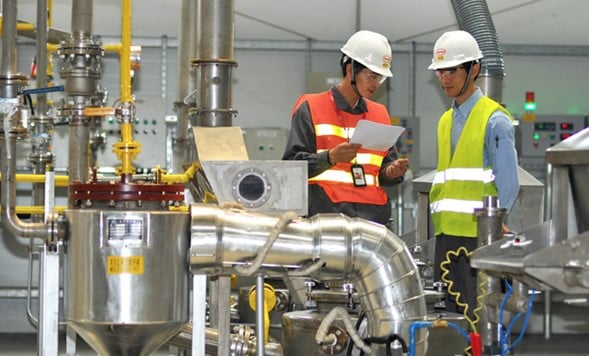In a world where environmental sustainability and operational efficiency are more critical than ever, the oil and gas industry faces unique challenges. Here, asset reliability is not just operational optimization, but a fundamental pillar for the sustainable future of the industry.
This article focuses on the intrinsic relationship between asset reliability and environmental sustainability in the Oil & Gas sector, highlighting how strategic investments and innovations in this field are changing the energy landscape.
This comprehensive approach is necessary for any professional or entity involved in the energy sector, it opens opportunities to innovate, improve and lead in a market increasingly oriented towards sustainable and responsible practices. Join us on this journey through a topic of vital importance, where every decision and technical advance not only determines business success.
The importance of asset reliability
This methodology in the oil and gas industry refers to the ability of an asset to perform its required function efficiently and safely over its expected life cycle. This involves not only maintaining the operation of the equipment, but also ensuring that its operation does not compromise safety or the environment.
In a sector where equipment and technologies are subjected to extreme conditions and constant pressure to maintain high standards of safety and efficiency, this tool is a critical aspect. In the oil and gas industry, asset reliability is important for several reasons:
- Reduces greenhouse gas emissions: Reliable assets allow businesses to operate more efficiently, reducing the amount of fuel consumed and greenhouse gas emissions generated. For example, oil and gas operator BP estimates that a 1% improvement in the reliability of its assets could save it 200,000 tons of CO2 emissionsCO2 year.
- Prevents environmental accidents: Reliable assets allow companies to prevent environmental accidents, such as oil spills or gas leaks. For example, oil and gas operator Shell estimates that a 1,000-barrel oil spill could cause up to $100 million in environmental damage.
- Reduces consumption of natural resources : allowing companies to use natural resources more efficiently, helping to conserve them for future generations. For example, oil and gas operator ExxonMobil estimates that a 1% improvement in the reliability of its assets could save it 10 million barrels of oil a year.
Economic and environmental impact of asset failures
Asset failures can have devastating consequences both economically and environmentally. According to a study by market analysis firm Frost & Sullivan, unplanned disruptions in the oil and gas industry can cost companies up to $42 million annually.
Additionally, the International Energy Agency (IEA) has reported that emissions of methane, a potent greenhouse gas, are often due to faulty equipment or failures in gas systems. Example of this topic are:
- A notable example of the consequences of an asset failure is the Deepwater Horizon incident in 2010. This catastrophe, caused in part by the failure of critical equipment, resulted in the deaths of 11 workers and the spill of approximately 4.9 million barrels of oil into the Gulf of Mexico, with a massive environmental impact and significant economic losses for the BP company. .
- Another case is the oil spill in the Niger Delta, where the lack of maintenance and the age of infrastructure have resulted in multiple spills, affecting both the environment and local communities. The NGO Environmental Rights Action/Friends of the Earth Nigeria has reported that these spills have caused serious pollution and have affected the lives of thousands of people in the region.
Investment in asset reliability
The oil and gas industry is under increasing pressure to reduce its environmental impact. Companies in the sector are investing in new technologies and innovations to improve industrial assets, allowing them to operate more efficiently and reduce their greenhouse gas emissions, prevent environmental accidents and reduce the consumption of natural resources.
Some of the actions companies are taking include:
Predictive and Preventive Maintenance
Predictive and Preventive Maintenance (PdM/PdP) is one of the most important innovations in asset reliability. These techniques allow companies to identify and correct potential problems before failures occur (Figure 1).
Predictive Maintenance uses sensor data to detect signs of wear or deterioration before they cause failure. Preventive Maintenance, on the other hand, is based on a scheduled maintenance program to prevent asset failure.
Companies in the oil and gas sector are increasingly adopting PdM/PdP to reduce their greenhouse gas emissions. For example, Halliburton developed a Predictive Maintenance program that helped reduce equipment failures by 50%. This translated into a reduction in greenhouse gas emissions by 250,000 tons per year.

Use of high quality materials and equipment
The use of high-quality materials and equipment is another innovation that is helping to improve asset reliability in the oil and gas industry. These materials and equipment are more resistant to wear and adverse conditions, reducing the risk of failure. For example, Schlumberger developed a new type of pipe coating that is more resistant to corrosion. This new coating helped reduce gas leaks by 20%.
Digitization
Digitalization is transforming the way companies operate their assets. Digital technologies, such as artificial intelligence (AI), machine learning and data analytics, are allowing companies to collect and analyze data from their assets more efficiently.
This information can be used to identify potential problems, improve operations efficiency, and reduce the risk of failure. For example, ExxonMobil uses AI to predict equipment performance and likelihood of failure. This information helps the company better plan maintenance and reduce the risk of production interruptions.
Adequacy of assets
Many of the operators and companies in the sector are improving metallurgies in existing assets in order to improve their operability and therefore the impact of a failure that could impact the environment and the safety of their personnel. Such is the case in pipes that according to design are made of Carbon Steel; which in service present high corrosion rates (>20 mpy); they are replaced by pipes made of Chromium material to increase their useful life.
These investments are helping companies reduce their environmental impact and become more profitable.
Current challenges in improving asset reliability
One of the main challenges in the oil and gas industry is balancing the need for asset reliability with the constant pressure to reduce costs and optimize resources. In an environment where profit margins often depend on the fluctuating price of crude oil, companies face the dilemma of investing in equipment maintenance and upgrades or reducing expenses.
Additionally, aging infrastructure at many oil and natural gas facilities is a growing concern. According to a report by the International Energy Agency, more than 50% of the infrastructure in certain producing regions is more than 30 years old, which increases the risk of failures and accidents.
Future prospects and emerging trends
Looking ahead, the oil and gas industry is expected to lean towards digital and automated solutions to improve asset reliability.
Adoption of technologies such as predictive analytics and artificial intelligence is on the rise. These technologies not only allow predicting and preventing asset failures before they occur (Figure 2), but also help optimize operations and reduce costs. It is estimated that the use of digital technologies can reduce operating costs by up to 20%.

Expert opinions
Experts such as Daniel Yergin, vice president of IHS Markit and author of “The New Map: Energy, Climate, and the Clash of Nations,” say asset reliability will become increasingly important as the industry moves into the future. greener and more sustainable. Yergin highlights that innovation in asset management is not only crucial for efficiency and profitability, but also for meeting increasing environmental regulations and stakeholder expectations.
Success stories
There are several success stories that demonstrate the positive impact of this methodology on the environmental sustainability of the oil and gas industry.
For example, oilfield services company Halliburton developed a predictive maintenance program that helped reduce equipment failures by 50%. This translated into a reduction in greenhouse gas emissions by 250,000 tons per year.
Conclusion
Asset reliability in the oil and gas industry is a considerable pillar for safe, efficient and sustainable operation. Companies that invest in the continuous improvement of their assets are not only ensuring a more profitable and efficient operation, but are also contributing to a greener and more responsible future. The relationship between asset reliability and environmental sustainability is therefore a critical component for the future of the industry, requiring continued attention, innovation and action.
“To delve deeper into how asset reliability can transform your business in the oil and gas industry towards a more sustainable and efficient operation, contact us today and explore our innovative solutions.”
References
- Predictive 21: For topics related to Reliability and environmental sustainability in the oil and gas industry.
- Publications and lectures by Darren Woods, CEO of ExxonMobil: For expert opinions on the importance of asset reliability.
- Sector studies on the use of digital technologies in the oil and gas industry: For data on the impact of digitalization and AI on reducing operating costs.
- Reports of industrial accidents and catastrophes, such as the Deepwater Horizon incident: These can be found in industrial safety databases and reports from government agencies.

